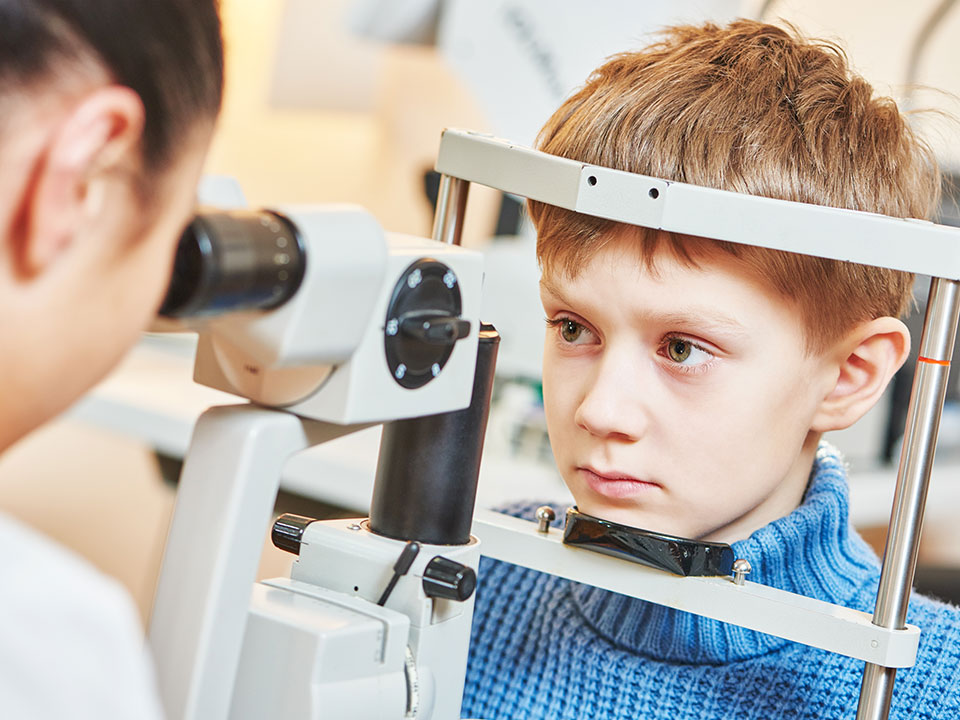Everything You Need to Know About Cataracts in Babies & Children

You might be thinking that cataracts are only for older adults. On the contrary, babies and children are also at risk of developing them.
If you suspect your child might suffer from the condition, you should always visit your pediatric optometrist for an eye examination. Cataract treatment is effective, especially if the condition is diagnosed early.
What Are Cataracts?
Cataracts are cloudy regions that form in the lens of the eye. Cataracts occur when changes to the eye lens cause them to become less transparent.
In most cases, cataracts develop slowly and do not interfere with your eyesight. However, if the condition becomes too progressive, you might notice a large or dense fog in the eyes, leading to blurry vision or even blocking out vision completely.
Why Does My Child Have Cataracts?
Children can also develop cataracts at an early age. The condition is also known as childhood cataracts.
Cloudy vision may affect a small part of the lens and go unnoticed until it is too late. As the cataract grows, it might cover the pupil leading to complete vision loss.
There are four types of childhood cataracts:
Congenital Cataracts
Congenital cataracts develop shortly after birth. The condition can happen in one or both eyes. However, in most cases, the condition does not affect the child’s vision. That means cataracts do not need any removal.
Secondary Cataracts
These cataracts are mainly present if your child suffers from an underlying illness. Diabetes or eye-related issues can cause significant progress of cataracts which might need intervention.
Traumatic Cataracts
These cataracts happen after a child gets an eye injury. The condition can occur right after the injury or a few years later.
Radiation Cataracts
Cataracts can also form if a child is exposed to radiation.
What Causes Cataracts in A Child?
There are several reasons why your child might be developing cataracts.
- Chromosomal problems
- Family heritage
- Diabetes
- Poisoning
- Chickenpox
- Glaucoma
- Rubella
- Injury
- Rheumatoid arthritis
- Using steroids
What Are the Symptoms of Cataracts in Children?
Let us look at a few telltales that can help you identify the signs of childhood cataracts.
1. Cloudy Patches Around the Pupil
The most apparent sign of cataract development is white or gray patches appearing in the eye lens. As the condition progresses, the spots become more prominent and visible, affecting the child’s vision.
2. Blurry Vision
Your child might develop a cloudy, blurred, or dim vision as cataracts progress. This is caused by the lens losing most of its transparency and not allowing enough light to reach the retina, which is the light-sensitive layer in the eye.
3. Night Blindness
In addition, if not enough light gets to the retina, there is a higher possibility of children having difficulty seeing at night.
4. Glares and Light Sensitivity
As the cloudy mist becomes denser, it scatters and blocks some light from passing through the lens. This scattering results in glares and also exaggerates light perception causing sensitivity to bright lights.
In addition, children with cataracts are also prone to seeing halos around lights.
5. Fading colors
Fading colors are also a common symptom of cataracts. Children with cataracts might notice some colors are faded due to light getting blocked from entering the lens.
6. Double Vision
Cataracts can develop at different rates in your child’s eyes. In this case, both eyes have trouble working together to create the same image, leading to a distortion in vision.
7. Changing Correction Lenses Frequently
If your child changes prescription glasses or contact lenses frequently, they might suffer from cataracts. As the condition progresses, they might need a stronger prescription to improve their eyesight.
If you notice any of these symptoms with your baby, no matter how small, you should book an appointment with an eye specialist.
How Do You Treat Cataracts in Children?
Regular checkups are essential to maintaining your child’s eye health. You should take your newborn for an eye check to examine for congenital cataracts as early as six months. However, if you notice cloudiness in your kid’s eyes before then, you should schedule an appointment with the eye specialist as soon as possible.
The only way to treat cataracts is by performing surgery to remove them. If your child’s cataract is small and does not affect their vision, it might not be necessary to have it removed. However, if the condition progresses, it is vital to remove it before it leads to vision loss.
Before the eye surgery, your doctor will perform a thorough examination to determine the condition’s progress. When you go in for the procedure, the surgeon will administer general anesthesia to numb the eyes but keep the child awake through the surgery. The doctor will remove cataracts by making a small incision into the lens.
After surgery, your optometrist might recommend aftercare procedures to help your kids recover. In addition, the doctor might also prescribe artificial lens implants, wearing corrective glasses or contact lenses to improve vision.
What Should You Do After Cataract Surgery?
Cataract surgery is often an outpatient procedure, and your child can go home the same day.
Recovery is often quick, especially for children; their vision should return to normal in a couple of weeks. However, for the first few days, after the procedure, kids might have slight discomfort, swelling, and redness in the eyes.
Your optometrist will prescribe eye drops to keep the eyes from drying up and reduce swelling. In addition, they might also be prescribed antibiotics to prevent infections.
If you notice the swelling or redness is not going down, you should book an appointment with your doctor immediately. It might be a sign of an eye infection.
Are There Risks in Treating Cataracts in Children?
Cataract removal is safe, and you should not worry about the procedure. However, the most significant risk to the surgery is the development of an infection.
How Can You Prevent Cataracts in Children?
If your family suffers from cataracts, preventing the condition from appearing in your kids might be challenging.
However, talking to your OB-GYN during pregnancy can help prevent infections that might lead to childhood cataracts. Also, make sure that you get vaccinated during pregnancy.
Final Thoughts
Early diagnosis of childhood cataracts can help save your baby’s vision. It is essential to schedule an appointment with your optometrist to check and diagnose any eye issues your child might be experiencing.




